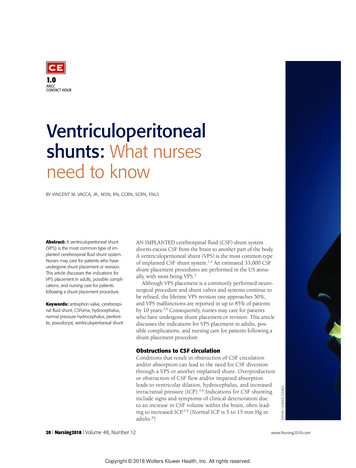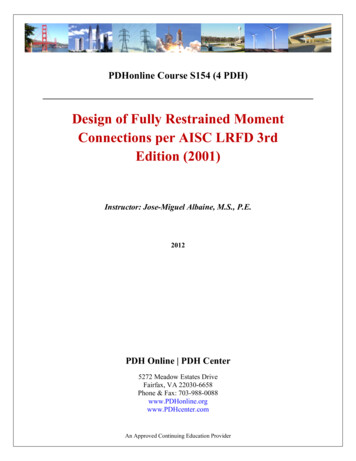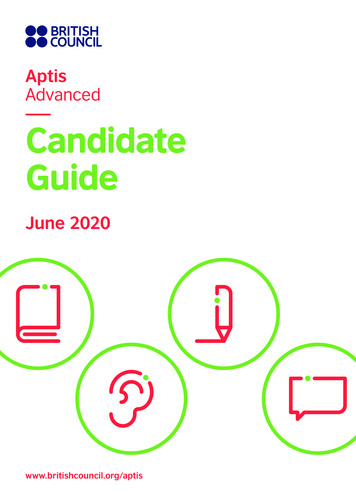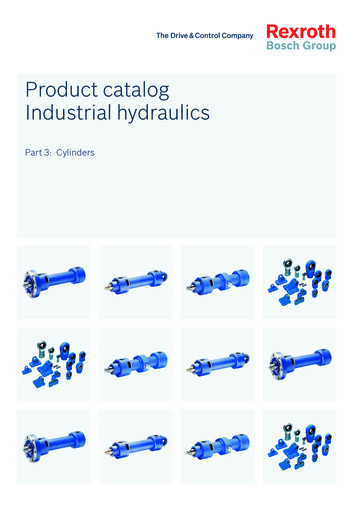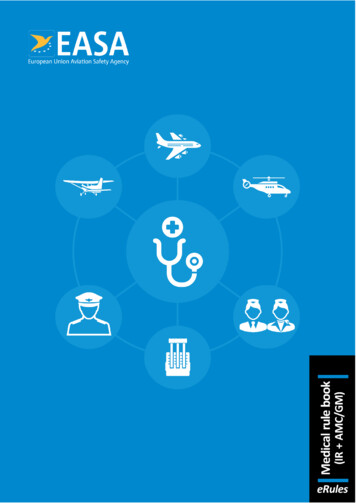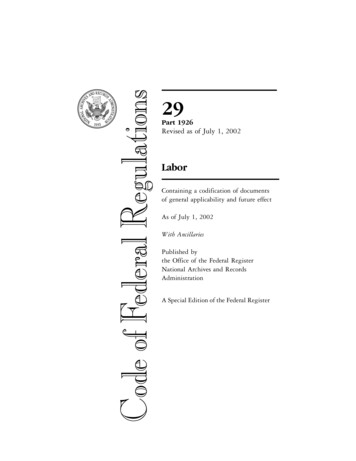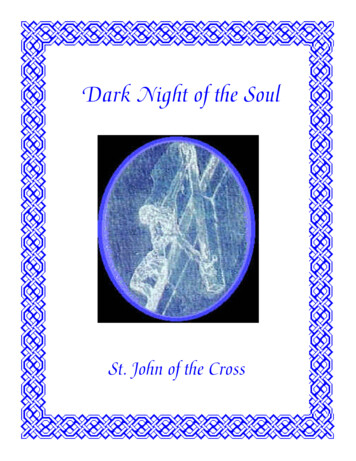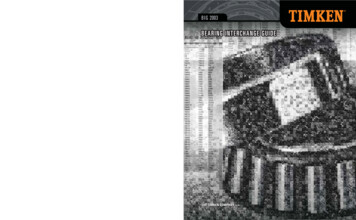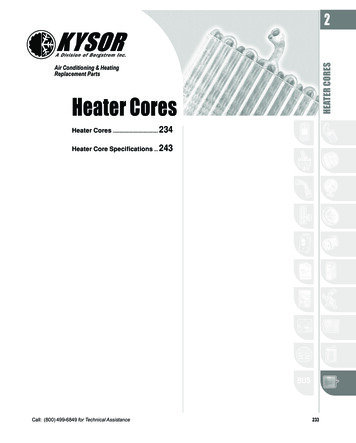
Transcription
PART INeuromuscularTherapy BasicsLWBK636 c01[01-10].indd 18/9/10 4:57:29 PM
LWBK636 c01[01-10].indd 28/9/10 4:57:46 PM
INTRODUCTION TONEUROMUSCULARTHERAPY 1KEY TERMSAcute: of recent onsetChronic: of long standingConcentric strain: a condition in which a muscle is chronicallyshortened because of overuse or postural dysfunction; itsopposing muscle will most likely be eccentrically strained, oroverstretchedEtiology: the cause of diseaseHypertonicity: excess muscular tonusIschemia: local and temporary deficiency of blood supplyNeuromuscular therapy is a comprehensive and advanced systemof soft tissue manipulation that specializes in working with chronicmyofascial pain and pain syndromes. On the basis of neurological laws, this therapy works toward bringing the body’s centralnervous system into homeostatic balance with the musculoskeletalsystem using various Swedish massage strokes, such as effleurage, pétrissage, and deep transverse friction, along with triggerpoint release.Neuromuscular therapy techniques, along with a thoroughstructural evaluation, are needed to understand and treat the causative factors involved in acute, or of rapid onset, and chronic, orlong-lasting, myofascial pain and dysfunction. Specifically, neuromuscular therapy is used to deactivate trigger points in muscle,tendon, and ligaments. It is also used to lengthen chronically shortened muscles and balance muscle groups, especially when workingwith people suffering from postural dysfunction or distortion, suchas internal rotation of a shoulder girdle or scoliosis.Thus, being trained in this therapy will allow a massage therapist to specialize in working with chronic myofascial pain andpain syndromes and take an active role in helping people over-Noxious: harmful or painfulPostural and biomechanical dysfunction: abnormal function ofthe body because of poor posture and poor biomechanicsRange of motion: the amount of movement of a jointTrigger point: an area of hypersensitivity that whencompressed creates referral sensation at a distance from thatareaTrigger point referral: the sensation felt at a distance from atrigger pointcome injuries and postural dysfunction. If we can balance eacharea of the body, we can help people change their posture andgait. This work may also be used to enhance the function ofjoints, muscles, and general biomechanics of the body whilespeeding healing by the facilitation of release of endorphins, thebody’s natural painkillers.Neuromuscular therapy has many broad applications intoday’s health care setting. It is used to treat people who sufferfrom acute or chronic pain stemming from various injuries, suchas those related to the following: Sports injuries, such as strains and sprains Automobile injuries, such as whiplash Repetitive strain injuries, such as epicondylitis, carpal tunnel syndrome, etc. Accumulative trauma injuries, such as temporomandibularjoint dysfunction Skeletal problems, such as spinal disc herniationThere are, of course, many more uses for this technique. Thereare only a few contraindications, however. The most common3LWBK636 c01[01-10].indd 38/9/10 4:57:46 PM
4 PA R T I / N E U R O M U S C U L A R T H E R A P Y B A S I C Sinclude large bruises, phlebitis, varicose veins, open wounds, andskin infections.In addition to massage therapists, many other health careprofessionals use neuromuscular therapy today. These includechiropractors, physiatrists, nurses, physical therapists, occupational therapists, osteopaths, and dentists.The purpose of this chapter is to introduce you to neuromuscular therapy and provide you with foundational information youwill need to become an effective practitioner of this modality.Specifically, we will consider how neuromuscular therapy works,what the key components of a session are, a brief history of themodality, goals and therapeutic intent, knowledge and toolsrequired, and how to effectively relate to clients. HOW IT WORKSIn neuromuscular therapy, therapists first assess the body’ssoft tissues to locate chronically shortened muscles and trigger points, using effleurage, pétrissage, and friction. Oncethe areas in question are identified, more specific techniquesare used.Lengthening techniques such as myofascial release, deepeffleurage, muscle stripping, and passive stretching are performed to help break the concentric strain, or chronically,pathologically shortened muscles. A concentric contractionoccurs in a muscle when both ends of the muscle are broughtcloser together, shortening the muscle during the activephase of muscle contraction. Trigger point pressure or a pincer technique is used to deactivate the trigger points formedin the soft tissues (Fig. 1-1). Once a client is able, practitioners add active stretching to the treatment schedule.This helps the client to increase range of motion, or theamount of movement in any given joint, that has been compromised by pain and discomfort.By lengthening chronically shortened muscles, this therapy helps clients recover their range of motion. By deactivating trigger points, it relieves clients of the pain and othersensation brought about by the trigger points.Not only does neuromuscular therapy treat pain and sensation that is local to trigger points, but it also treats pain that is“referred” to parts of the body distant from the actual site ofthe trigger point. This type of pain is known as referred pain.Skeletal muscle makes up approximately 50% of thebody’s weight and can develop trigger points that producesensations such as varying degrees of pain, itching, tickling,and thermal sensation (hot or cold). It is daily activity thatcauses the most wear and tear on the muscle tissue in ourbodies. If the client is experiencing pain as the sensation ofreferral from trigger points, it could be extreme pain. COMPONENTS OF THE TECHNIQUEThe technique approach in this text is an integration of several different approaches that produce optimum therapeuticimpact when working with chronic myofascial pain. The following is the list of the components of this approach: Health history intake, evaluation, and assessment skills Soft tissue assessment and treatment Trigger point therapy (Fig. 1-2) Myofascial release and other lengthening techniques Passive stretches, muscle energy technique, and activestretching Postural stress analysis Identifying and reducing perpetuating factors Client management and follow-upThese components will be discussed in greater detailthroughout the book. HISTORY FIGURE 1-1Horse receiving neuromuscular therapy. Even horseshave trigger points that can be effectively deactivated usingneuromuscular therapy.LWBK636 c01[01-10].indd 4There have been many people involved with the origins ofneuromuscular therapy. Most agree that the first to discoverand develop this technique was a European named StanleyLief, who was trained in osteopathy and naturopathy. Liefestablished a famous natural healing resort, Champneys, inHertfordshire, England, in 1925. Along with Boris Chaitow,his cousin, Lief studied with teachers such as DewanchandVarma and Bernard MacFadden to become competent withthe concepts of assessment and treatment of soft tissue dysfunction. Lief and Chaitow, also trained in osteopathy andnaturopathy, began using these methods of assessment andsoft tissue manipulation on the patients coming to the8/9/10 4:57:51 PM
CHAPTER 1 / INTRODUCTION TO NEUROMUSCULAR THERAPY FIGURE 1-2Pressure to a trigger point.healing resort. They spent the years between the late 1930sand early 1940s testing and developing these theories andtechniques. The techniques they used then very closelyresemble the techniques we use today. Lief’s idea of neuromuscular therapy (called “neuromuscular techniques” inEurope) incorporated a holistic approach to healing by usingnutrition, psychology, hydrotherapy, and soft tissue manipulation.1 Lief’s methods eventually became incorporated intothe training system at the British College of Naturopathyand Osteopathy.Since then, several other osteopaths and naturopaths,such as Peter Lief, Brian Youngs, Terry Moule, and LeonChaitow, have further developed this work. Osteopaths andchiropractors have included the use of some of the techniques used with neuromuscular therapy to manipulate softtissue. It has been this use of techniques that has helped todevelop this work. Neuromuscular therapy is consequentlynow being taught in osteopathic and sports massage institutions in Great Britain.Within a few years of neuromuscular therapy emerging inEurope, Americans Raymond Nimmo and James Vannersonpublished a newsletter called the Receptor Tonus Techniques.In this publication, they described their experiences withnoxious nodules. These noxious nodules are what we nowcall trigger points. According to Travell and Simons, “Itnow appears that the most reliable diagnostic criterion ofLWBK636 c01[01-10].indd 55trigger points on examination of the muscle is the presenceof exquisite tenderness at a nodule in a palpable taut band.”Over the course of several decades, neuromuscular therapyas a distinct system began to develop, supported by the writings of Janet Travell and David Simons.In the late 1970s, a student of Nimmo, Paul St. John,began teaching his system of this technique. He has traveledthe United States training massage therapists and challenging the massage industry to become competent in the studyof anatomy and kinesiology. Judith (Walker) DeLany beganteaching with St. John in the mid-1980s and has gone on todevelop her own version of this modality, teaching it acrossthe United States.St. John has recently upgraded his teaching program andrenamed it as “Neurosomatics.” Specifically, his programapplies Travell and Simons’ information about radiographyto determine core body asymmetry and shoe reconstructionto help correctly realign posture.European and American versions of neuromuscular therapyare very similar in theory but different in the hands-on techniques. Both versions agree on the need to incorporate ahome-care program encouraging clients’ commitment andparticipation in their healing process. A primary focus for bothversions is to understand the formation, the cause of disease, oretiology, and treatment of trigger points, locating the source ofreferral, any perpetuating factors, and reducing and or eliminating them. One of the goals of this method of soft tissuemanipulation is to promote the person to independence.Janet Travell and David Simons published a two-volumeset of textbooks for the medical professions, called MyofascialPain and Dysfunction: The Trigger Point Manual, that hasimpacted the medical, dental, and massage communities.This is the first definitive exposition on myofascial triggerpoints, making these coauthors true pioneers in the understanding of trigger points and myofascial pain.Before treating pain, Dr. Travell taught clinical pharmacology at Cornell University and was a heart specialistin New York in the mid-1950s. Interestingly, her father,Dr. Willard Travell of New York City, had specialized inthe study of pain, and particularly the pain of musclespasms. Later, she served as President John F. Kennedy’spersonal physician, treating his chronic back problems.She became a specialist in treating muscle pain and, ingeneral, pain management.Janet Travell published more than 40 papers on myofascial trigger points between the years 1942 and 1990. DavidSimons has long experience as a research scientist andworked as an aerospace physician. After hearing a lecture byJanet Travell, he was intrigued by her work. When he retiredfrom the Air Force, he began an apprenticeship with her.They worked together for 20 years before producing The8/9/10 4:57:52 PM
6 PA R T I / N E U R O M U S C U L A R T H E R A P Y B A S I C STrigger Point Manual. The first volume of The Trigger PointManual was published in 1983. GOALS AND THERAPEUTIC INTENTAs with any type or style of bodywork, the therapist’s intentis important. With the proper intent, the therapist’s energymay actually help make the work more dynamic. This, alongwith choosing the correct approach for the area of the bodybeing worked, should be given serious consideration.Historically, neuromuscular therapy involves a thoroughand systematic examination of the muscles and other softtissues to isolate and identify “noxious” (harmful or painful)points and then treat these tissues with various methods. Anessential theoretical component to the approach is that thepractitioner is working directly and therapeutically with theneuromuscular system, function of which is adverselyaffected in the establishment of chronic myofascial pain.The goals and therapeutic intent of neuromuscular therapy are as follows: Identify and isolate tissue irregularities related tochronic myofascial pain, perhaps mapping these on abody chart for future reference Restore local tissue circulation and reduce ischemia—local and temporary deficiency of blood supply—sothat the tissues there will begin to heal Reduce hypertonicity—excess muscular tonus—andspasm to regain integrity Reduce soft tissue pain Reduce and eliminate noxious or excessive nerve stimulation and normalize reflex activity of the neuromuscular system Reduce and eliminate trigger points Restore normal range of motion to affected muscles Release related adhesions or fascial binding andlengthen chronically shortened muscles, fascia, andother soft tissue Identify and reduce or eliminate the perpetuating factors that continue to aggravate the trigger points andchronic pain patterns KNOWLEDGE AND TOOLS REQUIREDNeuromuscular therapy is an advanced form of soft tissuetherapy that requires skills and integration of several techniques. The following principles are essential to your successof this work.AnatomyA precise and thorough knowledge of musculoskeletalanatomy is necessary to confidently and effectively useLWBK636 c01[01-10].indd 6neuromuscular therapy techniques. When using neuromuscular therapy techniques, the therapist works directly onmuscle bellies, origins, and insertions. It is important toknow this information along with fiber direction of eachmuscle in both theory and practice. That is, the therapistshould not only be able to cite attachments but should alsofind them on the body and palpate them. The therapistmust also have an understanding of nerve reflexes andnerve physiology to be effective when using neuromuscular therapy, as the nervous system plays a central role inproducing and perpetuating chronic pain.“If you really want to utilize your intuition, know your anatomy!”—Paul St. JohnAlong with anatomic precision comes a much more comprehensive style of bodywork that invites one’s intuition tocome into play. To be able to use intuition, there must be acore body of knowledge to draw on. A neuromuscular therapist armed with precise anatomical and kinesiologicalknowledge, along with an understanding of the theory andpractice of neuromuscular therapy, will be able to use anyintuitional responses he comes across when reading over aclient’s health history form and assessment information and/or when actually working with the client’s soft tissues.Without the core body of knowledge, the intuition has noway of producing information.This is a fascinating subject that takes interest or passion,study, practical use, and time to master. You are encouragedto continue to study anatomy through all available means.Being able to palpate and work at an exact attachment siteof any muscle is crucial to the success of this work.Analysis and KinesiologyThe therapist also needs to develop an overall orientation tostress and trigger points with respect to the interrelatedness ofthe body’s structure and position. An understanding of structural kinesiology is a must here. Body reading, postural stressanalysis, and an examination of the client’s everyday use of hisor her body must become a part of a therapist’s repertoire toreduce and eliminate structurally based soft tissue problems.ToolsBesides being armed with knowledge, you also must have theproper tools with which to practice neuromuscular therapy.As with many forms of massage, an effective lubricant isneeded. Small amounts of lubrication—using gel, oil, lotion,or cream—are required at certain times during each session tomildly reduce friction to the skin. It is important, however, touse only as much lubrication as necessary to be able to properly engage the tissues, such as when performing effleurage, as8/9/10 4:57:54 PM
CHAPTER 1 / INTRODUCTION TO NEUROMUSCULAR THERAPY7Dependency, Participation, and Support FIGURE 1-3T-Bar pressure bar. Pressure bars are wooden toolswith rubber or plastic tips that can be used to apply pressure intothe tissues.a small amount of drag against the skin is required for this.Most nerve endings are at the level of skin. If you do not usea small amount of friction against the skin when treating anarea, you will miss the opportunity to treat tissue and bonedirectly below that area. Certain techniques, however, areperformed on dry skin to increase effectiveness. For example,when using any myofascial release techniques during a session, begin with them so they can be done before lubricatingfor best effectiveness.In addition, pressure bars can be an invaluable asset inperforming this modality. Pressure bars are wooden toolswith rubber or plastic tips that can be used to apply pressureinto the tissues. One such tool, a T-Bar with a beveled rubber tip, is used in routines presented in this book (Fig. 1-3).Pressure bars are particularly useful to reduce strain on thethumbs in doing extensive amounts of therapy, such as six toeight sessions per day. When using a pressure bar, be sure tohold it in a stable manner. With enough practice, the pressure bar will become a natural extension of the hand.Another tool, called “Thumby,” may be used to applyeffleurage, friction, and trigger point pressure. It is also anexcellent tool for a client to use at home for trigger pointwork. This is a device made of silicone and, like a pressurebar, can help reduce the strain on hands and thumbs,in particular. RELATING TO THE CLIENTAnother critical consideration when performing neuromuscular therapy is how you relate to the client. Discussed beloware how to avoid fostering dependency in your client andhow to promote his or her participation and provide support. Also discussed is how to effectively communicate withthe client during therapy.LWBK636 c01[01-10].indd 7As a massage therapist, you should feel privileged to serveeach client and be a part of his or her support system in life.However, you should be careful to not become part of adependency system.A dependant client is not a healthy client, as he is looking for a therapist, nurse, doctor, physical therapist, and soforth, to “fix” his problem. This is a client who feels “lessthan” the person he is dependant on. This places the therapist, in this situation, in a “greater than” position in theclient’s mind. The client then has expectations that thetherapist will fix his problem, and his own responsibilityends there. We want the client to feel responsible for hisrecovery rather than expecting us to do it all for him.For a client to recover and stay healthy, he must take onsome responsibility and understand that the therapist is onlyone of the tools he is choosing to use to recover. Now theresponsibility of recovery is his.To avoid this dependency system, encourage your clientsfrom the very first session to participate in the therapy andassist you in understanding their conditions.Client–Therapist CommunicationTo succeed in this vital work and to encourage participationfrom the client, you must establish effective, two-way communication with the client. Specifically, during the first session, communicate with the client to determine the extent ofischemia in tissues, find the location and referred zones of trigger points, and determine the ability of the tissues to releasespasms and respond to the therapy. This communication canbe accomplished by asking the client the following three questions and listening carefully to his or her responses.1. Where is it tender or sensitive to my touch? Tissuesthat are in a hypercontracted state are more tenderthan that of healthy, flexible tissues. In questioning theclient about this, be careful not to use words that mayhave a negative connotation, such as “painful” or “hurting.” Use more positive terms when referring to tissues,such as “tender” or “sensitive,” so that the client doesnot associate your work with causing pain. Furthermore,many therapists ask their clients to rate their discomfort on a scale from 1 to 10, with 10 being the greatestdiscomfort. Having this information will not only letyou know what your client is experiencing at themoment but also how effective the treatment is later,when you again ask them to rate their discomfort.2. Do you feel any referred sensations to other parts ofyour body? Explain to the client what “referred”means and that these sensations might include tingling, burning, numbness, pain, or thermal sensations.8/9/10 4:57:54 PM
8 PA R T I / N E U R O M U S C U L A R T H E R A P Y B A S I C SIt is important for the client to know that a referralsensation may be something other than pain. Withoutthat knowledge, a client might not relate to the therapist certain sensations that may be coming from trigger points and the work you are doing with them.Often when discussing trigger points, therapists,teachers, and authors call the referral sensation areferral pain only. When this is the case, some maynot understand that pain is only one of several sensations that can occur because of trigger points.3. Do you feel a release or decrease in discomfort as Ipress on this area? Ask this question as you are pressingand holding a trigger point for 10 or more seconds. If youare using the numbered scale, as described above, havethe client rate the level of discomfort from moment tomoment to indicate any changes. Some therapists, however, find this method distracting to clients—possiblycausing them to focus more on the discomfort itself thanon the release—and simply ask clients to let them knowwhen the discomfort changes or lessens. Try both systemsto see which works best for you. PRECAUTIONSPrecautions must always be taken when working with a client. This helps us keep our work safe for the client to receive.Some precautions are very general and are used with anymassage work, whereas others are quite specific to an area.These precautions include, but are not limited to, thingssuch as being sure the client does not have an unstable heartcondition, untreated high blood pressure, brittle diabetes(especially when working on legs), varicosities, bruises, phlebitis, broken bones, inflammation, and sunburn. Fears ofbeing injured during bodywork need to be considered, alongwith restricted range of motion, very recent surgery, anupcoming sports event within the next 5 days, or degenerative arthritis, pregnancy, and disc herniation.Precautions regarding the performance of this workinclude being sure that the referral patterns, pain, and triggerpoints you are treating actually lend themselves to neuromuscular therapy. A client demonstrating signs of swelling,discoloration, or neurological symptoms should be referredto the appropriate health care provider.CHAPTER SUMMARYIn this chapter, we have looked at some of the basics of neuromuscular therapy, including a brief explanation of how itworks, its components, and its history. We have also considered the goals of this modality and the importance of therapeutic intent when performing it. Finally, we have learned theessential knowledge and tools required for this therapy andLWBK636 c01[01-10].indd 8how to relate effectively with clients. However, it is importantto note that you need more than this information to administer a neuromuscular therapy session; you need to use criticalthinking in applying this information. You may then ensure atreatment session that will produce the most effective resultspossible in the shortest amount of time necessary.8/9/10 4:57:55 PM
CHAPTER 1 / INTRODUCTION TO NEUROMUSCULAR THERAPY9 REVIEW QUESTIONSShort Answer Questions1. Describe neuromuscular therapy.2. List at least three of the goals and therapeutic intents ofneuromuscular therapy.3. Regarding the approach for neuromuscular therapy, listat least three of the components of performing thismodality.4. Name three techniques that are used to help locatechronically shortened muscles and trigger points.5. Neuromuscular therapy is a specialized technique.Which systems of the body does it tend to balance?Multiple Choice Questions6. What is necessary to apply neuromuscular therapyeffectively and with confidence?A. Palpatory artistry and good luckB. Precise and thorough knowledge of anatomyC. A medical degreeD. Really strong hands7. Who are known as the pioneers of trigger point therapyand myofascial pain?A. Raymond Nimmo and James VannersonB. Stanley Lief and Boris ChaitowC. Peter Lief and Leon ChaitowD. Janet Travell and David Simons8. In communicating with clients, many therapists like touse which of the following to evaluate the client’s discomfort level and the effectiveness of trigger pointrelease?A. A verbal discomfort scale from 1 to 10B. A stethoscopeC. A medical reflex hammerD. Needles9. When establishing communication with the client, whatthree areas are important to discuss with the client?A. Codependency, delinquency, and stress levelsB. The extent of ischemia, location of trigger pointsand referrals, and whether the tissues are releasing/responding to the workLWBK636 c01[01-10].indd 9C. Good jokes, problems with coworkers, and familyissuesD. All of the above10. Which types of injuries may be treated using neuromuscular therapy?A. Acute trauma and infectionsB. Repetitive strain and automobile accident injuriesC. Organ failure and accumulative traumaD. Inflammation and open woundsTrue/False11. The techniques we use to assess and locate chronicallyshortened muscles and trigger points are effleurage,pétrissage, and friction.12. Paul St. John was the first person to discover anddevelop neuromuscular therapy in Europe.13. The term acute usually refers to an injury of recentonset.14. We use very small amounts of lubrication when treating with neuromuscular therapy so that we can usefriction to more effectively stimulate the nerve endingsin skin.15. It is not necessary to have an understanding of structural kinesiology when using neuromuscular therapy.Matchinga. Pressure barsb. Postural dysfunctionc. Concentric contractiond. Range of motione. Referral sensationf. Eccentric contraction16. What one feels at a distance from an active triggerpoint?17. Internal rotation of a shoulder girdle and scoliosis areexamples of what?18. Name a wooden tool with various rubber or plastic tips.19. A type of contraction in which the muscle shortens inresponse to tension.20. Name the term used for the available movement at agiven joint?8/9/10 4:57:55 PM
1 0 PA R T I / N E U R O M U S C U L A R T H E R A P Y B A S I C SREFERENCE1. Chaitow L. Modern Neuromuscular Techniques. Philadelphia:Elsevier, 1996.LWBK636 c01[01-10].indd 108/9/10 4:57:56 PM
now being taught in osteopathic and sports massage institu-tions in Great Britain. Within a few years of neuromuscular therapy emerging in Europe, Americans Raymond Nimmo and James Vannerson published a newsletter called the Receptor Tonus Techniques. In this publicatio

